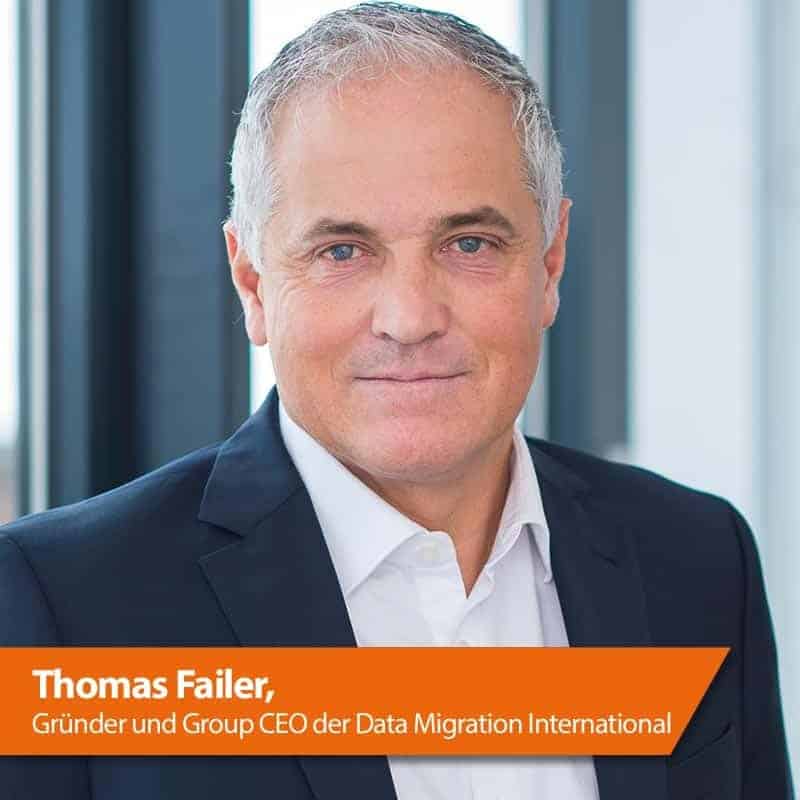Historical ERP data: simplify, automate and save money
![[shutterstock.com: 1663089904, Oleg Elkov]](https://e3mag.com/wp-content/uploads/2020/06/shutterstock_1663089904_cmyk.jpg)

The digital transformation demands intelligent answers in a wide variety of markets and industries that lead to sustainable long-term solutions despite the uncertainty under which business leaders must make decisions today.
This is all the more true as far-reaching restructuring is to be expected in many companies in the wake of the Corona crisis. Acquisitions and disposals, mergers, splits, mergers and dissolutions of business units, etc. will be on managers' agendas in order to successfully master the consequences of the crisis.
What's more, companies need to save money, and they need to do so in the short term. However, IT projects that make this possible must be in line with long-term strategies and measures.
The true enterprise value plays a decisive role in both the short and long term. The higher it is, the stronger the negotiating position and the greater the scope for action. To a significant extent, this value lies in the data and documents of the companies.
No wonder, then, that renowned analyst firms are increasingly emphasizing the importance of information in making companies more agile and thus increasing their value.
By information, they mean in particular so-called X and O data, i.e. transaction data from operations (O data) and all data relating to the user experience (X data, where X stands for experience). If you look at the successful data-driven business models of online providers, the focus on X and O data is only logical.
However, Internet providers are still youthful newcomers compared to companies in classic industries such as mechanical and plant engineering, automotive or textiles.
This certainly explains to a large extent why X and O data currently occupy such a prominent position. However, the knowledge of how to build vehicles efficiently and with consistently high quality is older than the design of an electric car and the corresponding control software.
The human body, its size and dimensions are not subject to the same changeability as viewers' tastes in series and films. That's why patterns from the 1950s, for example, are still part of the valuable intellectual property of a textile company.
Machinery and equipment have a life cycle of several decades, so not only construction plans but also maintenance reports over this period provide valuable insights.
These can provide a great service in the development of future products, even if the software portion of them will be much larger in the future. Finally, industries such as banking and insurance or the healthcare sector, which are currently particularly challenged by digitization, also have an immense treasure trove in their historical data, which they must retain for many decades for legal reasons alone.
Unlocking this treasure should provide valuable answers to today's digital challenges. It is therefore the total stock of information, both current and historical, that constitutes the true value of a company and adds to it.
Digital meets real
Here the lessons learned from the still young online business models, there the empirical knowledge from decades of business activity. Here the focus on short-term changes, there the long-term value of intellectual property acquired over many decades.
What looks like a contradiction, and probably was until a few years ago, is turning into a cooperation in the course of the digital transformation. In addition to the tried-and-tested blueprints, more and more data from the machines and systems will contribute to value creation in the future.
Analyses that indicate changes in consumer tastes allow textile companies to adapt to new trends more quickly and with greater precision in terms of target groups, and even to steer them. Automotive manufacturers can once again become innovation drivers with their proven process and production knowledge if they take full advantage of the opportunities offered by digitization.
The knowledge gained from customer histories, some of which span several generations, can give banks and insurance companies the edge they need when designing personalized digital offerings. The digital transformation is causing digital to meet real and history to meet zeitgeist everywhere.
The intelligent enterprise of the future therefore focuses not only on the X and O data, but also on the historical, the H data.
For corporate IT departments, this merging of X, O and H data and making them jointly usable is a challenge. They are all, but especially the H-data, distributed over many different and partly very old systems.
And their volume alone stands in the way of greater corporate agility. Typically, the proportion of corporate information that may no longer be changed, if only for legal reasons, accounts for 80 to 95 percent of the total volume in live systems.

Separate, automate, save
To turn history from an IT legacy into a source of higher value, it is important to separate X and O data from H data and manage the lifecycle of historical information separately on a dedicated platform.
This approach has numerous advantages: Significant cost savings are already achieved in the short term because the legacy systems can be completely decommissioned after the information has been separated and outsourced.
As a result, operating costs can usually be reduced by 80 percent compared to continuing to operate the legacy systems. Ideally, no upfront investment is required for this if the platform and its functionalities can be subscribed to as a service, as is common in the cloud age.
In addition, this transfer of legacy information - including the business context in which it was once created - allows the proportion of data and documents that have to be transferred to the operational systems to be drastically reduced. In the context of a transformation to SAP S/4 Hana, for example, this generally halves the effort required for data migration.
But beyond that, this short-term effect translates into long-term benefits: On the one hand, historical information can be regularly transferred to a separate information management platform.
Not only from systems that are to be decommissioned, but also from the operational solutions. These thus remain lean and agile in the long term - and do not require continuous resource expansion.
Against this background, reducing the total cost of ownership (TCO) of a new S/4 environment by 25 percent is not a pious hope, but a realistic estimate.
On the other hand, this approach also has a positive long-term effect in other scenarios. Companies can harmonize and consolidate their heterogeneous system and application landscapes, and even entire IT sites.
If they have sold subsidiaries or business units, they can select their data quickly and completely and transfer it to the buyer in a modern format. Furthermore, with this approach, companies increase the protection of their intellectual property and mitigate or eliminate legal risks.
The requirements of current and new legal regulations such as the EU-DSGVO or other regulations that demand complete management of the lifecycle of historical information can be met thanks to integrated retention management.
In addition, historical information and its business context remain 100 percent accessible despite being stored on a separate platform. This gives business users a complete view of customers and suppliers, for example. Companies can satisfy their obligation to provide evidence and information to internal auditors or external auditors at any time.
After all, such a platform is the prerequisite for Big Data scenarios of all kinds. With its help, legacy data can be cleaned up and optimized prior to audit-proof outsourcing and storage.
Duplicates can be deleted and incomplete data sets can be supplemented and enriched with information from other sources. This is crucial to making the promise of data-driven business processes and models come true.
Decisions made on the basis of data analysis are only as good as the quality of the data itself. This is all the more true in scenarios where mass data is generated. And these will be standard in the future.
Simplicity instead of complexity
Automation is the key to reducing complexity: complexity that arises from the heterogeneity of the application and system landscape. Complexity that is the result of too much information in the operational solutions.
Complexity that requires costly rework due to poor data quality. Complexity that can only be managed in migration and transformation projects by additional human and financial resources.
Specialization in the management of the lifecycle of historical information and the right connections of a platform suitable for this purpose to the operational systems create the prerequisites for this automation.
At the same time, it is the key that opens the door to the treasure trove of companies - to both current and historical information - and massively reduces the associated costs, regardless of their industry affiliation.
This is because the present and future value of a company lies in its information - a realization that is not rooted in the current crisis, but can make a decisive contribution to overcoming it.





